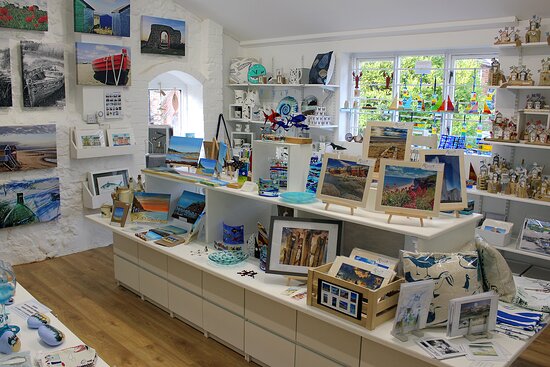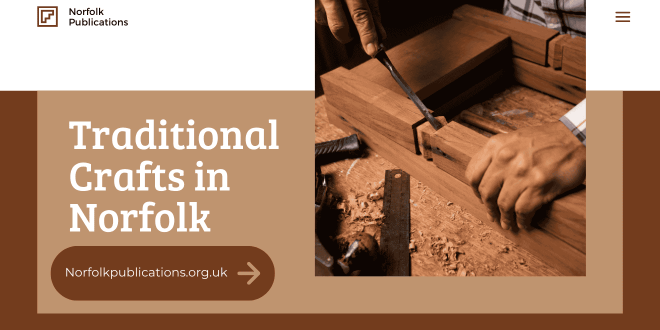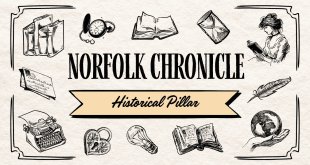Norfolk is a county that has lengthy been celebrated for its wealthy historical past, picturesque landscapes, and vibrant cultural traditions.
Whereas it’s maybe most well-known for its scenic shoreline and medieval structure, the area additionally boasts a wealth of conventional crafts which have been handed down by way of generations.
These crafts will not be solely a testomony to Norfolk’s historic heritage but in addition to its neighborhood’s resilience, creativity, and connection to the land.
Conventional Crafts in Norfolk

From basket weaving and pottery to the intricate artwork of textile making, Norfolk’s conventional crafts proceed to thrive, offering each locals and guests with a singular perception into the county’s artisanal tradition.
On this article, we are going to discover among the most iconic conventional crafts in Norfolk, their historic significance, and the way they’re being preserved and celebrated at the moment.
1. Basket Weaving
The Historical past of Basket Weaving in Norfolk
Basket weaving has an extended historical past in Norfolk, relationship again to prehistoric occasions when communities alongside the county’s rivers and marshes would use regionally sourced willow, reeds, and rushes to create baskets and containers for meals, instruments, and items. The apply of basket weaving was integral to the agricultural financial system, with craftspeople producing baskets for agricultural functions, equivalent to for gathering crops, storing items, or transporting fish.
All through the centuries, basket weaving turned a extremely specialised craft, with households passing down their weaving strategies from one technology to the subsequent. The proximity to the Norfolk Broads and the abundance of pure supplies within the space made the craft a vital a part of life in Norfolk’s rural communities.
The Craft Right now
Right now, basket weaving remains to be practiced in Norfolk, with artisans devoted to maintaining this historical craft alive. Native makers use conventional strategies to create every little thing from sturdy market baskets to ornamental gadgets. The supplies used—primarily willow—are nonetheless sourced regionally, guaranteeing that the craft stays carefully tied to the land.
Workshops and demonstrations are held all through the county, permitting individuals to study the craft for themselves. Basket weaving programs, provided by organizations such because the Norfolk Guild of Weavers, Spinners, and Dyers, appeal to each locals and vacationers keen to have interaction with this heritage craft.
2. Pottery and Ceramics
Norfolk’s Pottery Heritage
Pottery has been a vital craft in Norfolk for hundreds of years, with archaeological proof exhibiting that pottery manufacturing within the area dates again to the Roman occupation. Through the medieval interval, Norfolk turned a major heart for pottery, with kilns scattered all through the county, significantly in Norwich and Nice Yarmouth.
Pottery in Norfolk was traditionally used for each home and agricultural functions, with native clay getting used to craft all kinds of vessels, equivalent to pots, jugs, and bowls. These things weren’t solely sensible however typically featured intricate designs and decorations that mirrored the inventive sensibilities of their makers.
The Fashionable-Day Craft
The custom of pottery remains to be very a lot alive in Norfolk. Many native potters use conventional strategies to create each purposeful and ornamental ceramics. Norfolk pottery has turn out to be synonymous with high-quality craftsmanship, with up to date potters mixing historic strategies with trendy designs.
Workshops and pottery studios, such because the Burnham Pottery Studio, present an area for guests to see artisans at work and even strive their hand at pottery making. These studios supply a spread of pottery courses for all talent ranges, guaranteeing that the craft stays accessible to future generations.
3. Textile Weaving and Spinning
The Textile Custom in Norfolk
Textile weaving and spinning have performed a vital function in Norfolk’s financial system for hundreds of years. Through the medieval interval, Norwich was some of the necessary facilities for the wool commerce in England. Town’s weavers had been extremely expert, producing positive woolen material that was exported all through Europe. The trade flourished, and by the sixteenth century, Norwich had turn out to be synonymous with high-quality textiles, significantly its well-known Norwich shawls.
The weaving and spinning traditions in Norfolk weren’t restricted to the manufacturing of woolen items; flax was additionally grown within the area, with linen being produced for home and worldwide markets. Hand spinning and loom weaving had been widespread practices in properties throughout the county, with households working collectively to provide textiles for commerce and family use.
Preserving the Craft Right now
Whereas the textile trade in Norfolk has declined since its peak within the sixteenth and seventeenth centuries, the craft of weaving and spinning continues to thrive amongst artisans and hobbyists. The Norfolk Guild of Weavers, Spinners, and Dyers is devoted to preserving these conventional crafts by providing programs, workshops, and demonstrations all through the county. These occasions present a possibility for individuals to study concerning the craft’s historical past, strategies, and supplies.
Weaving and spinning programs are common with these trying to reconnect with their heritage or develop new inventive expertise. Artisans in Norfolk use a spread of fibers, together with wool, flax, and much more unique supplies like silk, to create stunning handcrafted textiles. The weaving looms and spinning wheels of the previous could have been changed by trendy instruments, however the dedication to craftsmanship stays the identical.
4. Norfolk Knitting
Historic Significance of Knitting
Knitting has lengthy been a conventional craft in Norfolk, with a wealthy historical past that dates again centuries. Through the nineteenth century, knitting turned a vital a part of the native financial system, with total households taking part within the manufacturing of knitwear. Norfolk’s fishermen, particularly, relied on hand-knitted clothes to maintain them heat at sea. The gansey, a conventional fishermen’s sweater, was a key garment that mixed practicality with craftsmanship.
Every fishing village had its personal distinctive gansey sample, typically handed down by way of generations of knitters. These intricate patterns served each an ornamental and purposeful goal, with tightly knit stitches offering heat and sturdiness within the harsh situations of the North Sea.
Knitting in Norfolk Right now
Right now, knitting continues to be a preferred craft in Norfolk, with many artisans and hobbyists devoted to preserving conventional strategies. The revival of curiosity in hand-knitted ganseys has led to a resurgence of this heritage craft, with knitters recreating historic patterns and incorporating them into trendy designs.
Knitting teams, workshops, and native yarn retailers supply alternatives for each newbies and skilled knitters to develop their expertise. The annual Norfolk Yarn Competition is a celebration of all issues fiber-related, bringing collectively knitters, spinners, and weavers to share their ardour for this conventional craft.
5. Reed Reducing and Thatching
The Historical past of Reed Reducing
Reed chopping and thatching are conventional crafts which have lengthy been related to the Norfolk Broads, one of many county’s most distinctive landscapes. The reeds that develop within the marshes and waterways of the Broads have been harvested for hundreds of years, with reed chopping enjoying an necessary function in each the native financial system and the preservation of the atmosphere.
Reeds had been traditionally used for thatching roofs, offering a sturdy and weather-resistant materials that might stand up to the weather. Thatching turned a extremely expert craft, with thatchers utilizing native reeds to create roofs that weren’t solely purposeful but in addition aesthetically pleasing.
Thatching in Fashionable Norfolk
Right now, the craft of thatching continues to be practiced in Norfolk, with expert artisans sustaining the custom of utilizing pure supplies to create roofs which can be each sustainable and delightful. The Norfolk Reed Reducing Affiliation works to protect the normal craft of reed chopping whereas selling the ecological advantages of sustaining the Broads’ reed beds.
Thatchers in Norfolk are in excessive demand, significantly for the restoration of historic buildings and cottages. Workshops and apprenticeships can be found for these interested by studying this specialised craft, guaranteeing that the custom of reed chopping and thatching will proceed for generations to come back.
6. Norfolk Lace Making
The Historical past of Lace Making
Lace making was as soon as a thriving trade in Norfolk, significantly within the 18th and nineteenth centuries. The intricate, handmade lace produced by Norfolk lace makers was extremely wanted for its delicate magnificence and craftsmanship. Whereas it was as soon as a family trade, with girls and youngsters working to provide lace for each native markets and export, the craft declined with the arrival of machine-made lace within the Victorian period.
Lace Making Right now
Regardless of the decline of the lace-making trade, there are nonetheless artisans in Norfolk who’re devoted to maintaining this intricate craft alive. Conventional strategies, equivalent to bobbin lace and needle lace, are taught in workshops and courses all through the county. These artisans use positive threads to create delicate patterns, typically impressed by historic designs.
Lace-making teams in Norfolk supply alternatives for fans to come back collectively, share their expertise, and make sure that this stunning craft continues to be practiced. Lace stays a logo of Norfolk’s wealthy artisanal heritage, with trendy lace makers mixing custom and innovation of their work.
7. Flint Knapping
The Historical Artwork of Flint Knapping
Flint knapping is likely one of the oldest crafts related to Norfolk, with proof of flint instruments being made within the area for hundreds of years. Through the Neolithic interval, flint was used to create instruments, weapons, and constructing supplies. The Grimes Graves, a prehistoric flint mine positioned in Norfolk, is a testomony to the county’s lengthy affiliation with this craft.
Flint knapping entails shaping items of flint by putting them with one other stone or instrument, a method that requires nice talent and precision. The ensuing instruments had been important for survival in prehistoric occasions, and the custom of flint knapping continued into the medieval interval, with flint getting used as a key constructing materials in Norfolk’s iconic flint church buildings.
Flint Knapping Right now
Whereas flint instruments are now not important for survival, flint knapping continues to be practiced in Norfolk as each a craft and a type of historic reenactment. Native artisans and hobbyists create flint instruments, arrowheads, and ornamental items, typically utilizing the identical strategies that had been employed by their ancestors.
Workshops and demonstrations of flint knapping are held at historic websites and museums throughout Norfolk, such because the Grimes Graves website, the place guests can study concerning the craft’s significance and even strive their hand at knapping.
Conclusion
The normal crafts of Norfolk will not be simply relics of the previous—they’re dwelling, respiratory elements of the county’s cultural heritage. Whether or not by way of basket weaving, pottery, textile arts, or flint knapping, these crafts supply a window into the lives and expertise of Norfolk’s ancestors. In addition they present a way for contemporary artisans to attach with their heritage whereas creating stunning and purposeful artistic endeavors.
As Norfolk continues to embrace its wealthy craft traditions, workshops, festivals, and native artisans play an important function in guaranteeing that these time-honored expertise are handed all the way down to future generations. For anybody interested by exploring Norfolk’s conventional crafts, there are numerous alternatives to study, interact, and be impressed by the area’s artisanal legacy.
 Norfolk Web Publications Web Publications in Norfolk!
Norfolk Web Publications Web Publications in Norfolk!

